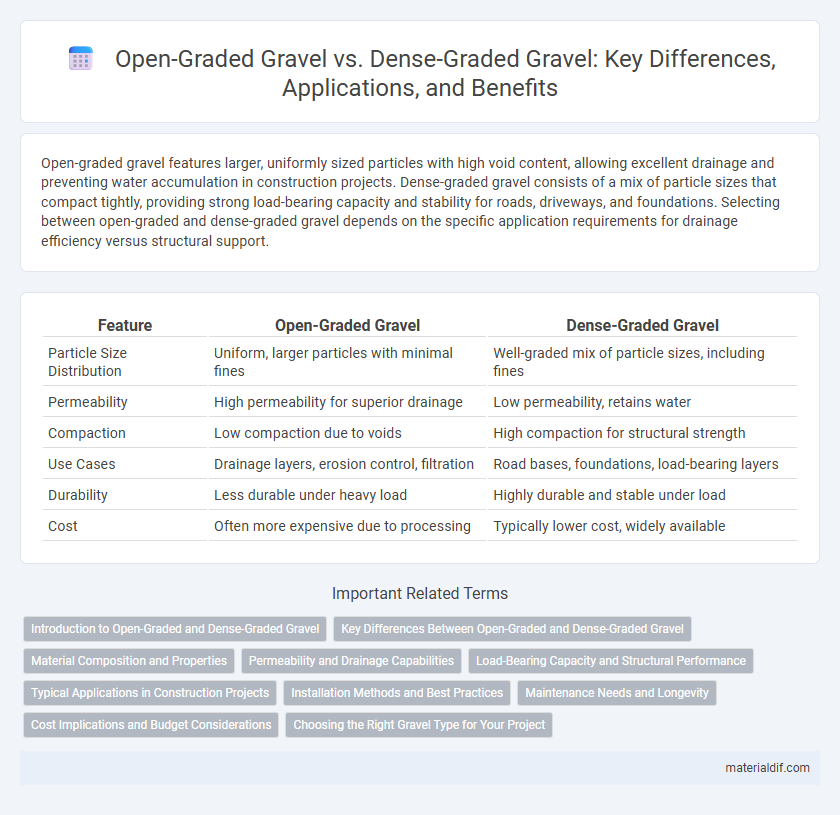Open-graded gravel features larger, uniformly sized particles with high void content, allowing excellent drainage and preventing water accumulation in construction projects. Dense-graded gravel consists of a mix of particle sizes that compact tightly, providing strong load-bearing capacity and stability for roads, driveways, and foundations. Selecting between open-graded and dense-graded gravel depends on the specific application requirements for drainage efficiency versus structural support.
Table of Comparison
| Feature | Open-Graded Gravel | Dense-Graded Gravel |
|---|---|---|
| Particle Size Distribution | Uniform, larger particles with minimal fines | Well-graded mix of particle sizes, including fines |
| Permeability | High permeability for superior drainage | Low permeability, retains water |
| Compaction | Low compaction due to voids | High compaction for structural strength |
| Use Cases | Drainage layers, erosion control, filtration | Road bases, foundations, load-bearing layers |
| Durability | Less durable under heavy load | Highly durable and stable under load |
| Cost | Often more expensive due to processing | Typically lower cost, widely available |
Introduction to Open-Graded and Dense-Graded Gravel
Open-graded gravel features larger particles with minimal fines, allowing superior drainage and air circulation, making it ideal for applications requiring quick water runoff. Dense-graded gravel consists of a well-graded mix of particle sizes including fines, resulting in a compact and stable surface suitable for heavy load-bearing and structural support. Understanding the distinct grading and particle distribution of these two gravel types is crucial for selecting the right material for construction, drainage, and landscaping projects.
Key Differences Between Open-Graded and Dense-Graded Gravel
Open-graded gravel features larger, uniformly sized particles with high void content, which enhances drainage and reduces surface water accumulation. Dense-graded gravel consists of a well-graded mix of particle sizes that compacts tightly, providing greater structural stability and load-bearing capacity. The key difference lies in permeability and compaction: open-graded gravel excels in drainage applications, while dense-graded gravel is ideal for strong, stable bases in road construction and heavy traffic areas.
Material Composition and Properties
Open-graded gravel consists of uniformly sized particles with minimal fines, creating high permeability and excellent drainage properties ideal for applications requiring water flow, such as drainage layers and filtration beds. Dense-graded gravel contains a mixture of particle sizes, including fine materials, which results in a compact, stable structure with reduced void space suited for load-bearing surfaces and pavements. The material composition of open-graded gravel emphasizes coarse aggregates with little to no fines, whereas dense-graded gravel balances coarse and fine aggregates to enhance strength and durability.
Permeability and Drainage Capabilities
Open-graded gravel features larger, uniformly-sized particles that create high permeability and superior drainage capabilities, making it ideal for applications requiring rapid water runoff. Dense-graded gravel consists of a wider range of particle sizes that compact tightly, reducing permeability and slowing drainage but providing greater stability and load-bearing capacity. Selecting between open-graded and dense-graded gravel depends on balancing effective water management with structural support needs.
Load-Bearing Capacity and Structural Performance
Open-graded gravel features larger, uniformly sized particles that create high void spaces, resulting in excellent drainage but lower load-bearing capacity due to reduced interlock among particles. Dense-graded gravel consists of a well-graded mix of particle sizes that tightly compact to provide superior structural performance and higher load-bearing capacity, making it ideal for supporting heavy loads and reducing settlement. Engineers often select dense-graded gravel for base layers in road construction to ensure long-term stability and resistance to deformation under traffic loading.
Typical Applications in Construction Projects
Open-graded gravel is commonly used for drainage layers in road bases, retaining wall backfill, and septic system beds due to its high permeability and ability to facilitate water flow. Dense-graded gravel, with its tightly packed particles, provides strong structural support and is ideal for use in base layers of pavements, sub-base courses, and heavy-load bearing applications. Construction projects often select open-graded gravel for erosion control and filtration, while dense-graded gravel is preferred for foundation stabilization and load distribution.
Installation Methods and Best Practices
Open-graded gravel consists of larger, uniformly sized particles that provide excellent drainage and are typically installed using a simple spread-and-compact method to maintain void spaces. Dense-graded gravel contains a mix of particle sizes that interlock tightly, requiring layered placement and thorough compaction with a roller or plate compactor to achieve stability and minimize settling. Best practices for both include proper subgrade preparation, moisture control during installation, and periodic maintenance to ensure long-term performance and prevent erosion or displacement.
Maintenance Needs and Longevity
Open-graded gravel, characterized by larger, uniformly sized particles, facilitates excellent drainage which reduces water retention and limits frost damage, thereby minimizing maintenance needs. Dense-graded gravel, composed of a mixture of various particle sizes, offers greater compaction and load-bearing capacity, enhancing surface stability but increasing susceptibility to drainage-related issues that require more frequent upkeep. Longevity of open-graded gravel surfaces often surpasses dense-graded ones in wet climates due to reduced erosion and rutting, while dense-graded gravel performs better in high-traffic areas demanding structural strength.
Cost Implications and Budget Considerations
Open-graded gravel typically costs more upfront due to the need for higher-quality materials and specialized installation techniques that ensure proper drainage. Dense-graded gravel tends to be more affordable and widely available, making it suitable for budget-conscious projects requiring a stable, compact surface. Considering long-term maintenance, open-graded gravel may reduce expenses by preventing water accumulation and associated damage, while dense-graded gravel could incur additional costs over time due to poorer drainage.
Choosing the Right Gravel Type for Your Project
Open-graded gravel features larger particles with minimal fines, promoting excellent drainage and is ideal for projects requiring water flow control such as drainage systems and base layers. Dense-graded gravel contains a mix of various particle sizes and fines, resulting in a compact, stable surface suitable for load-bearing applications like driveways, roads, and structural foundations. Selecting between open-graded and dense-graded gravel depends on the project's need for drainage efficiency versus compaction strength and load distribution.
Open-Graded Gravel vs Dense-Graded Gravel Infographic

 materialdif.com
materialdif.com